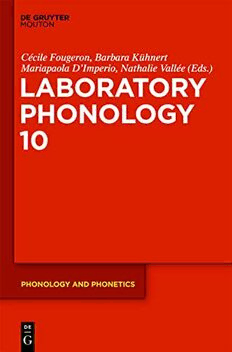
Laboratory Phonology 10 PDF
Preview Laboratory Phonology 10
Laboratory Phonology 10 Phonology and Phonetics 4-4 Editor Aditi Lahiri De Gruyter Mouton Laboratory Phonology 10 edited by Ce´cile Fougeron Barbara Kühnert Mariapaola D’Imperio Nathalie Valle´e De Gruyter Mouton ISBN 978-3-11-022490-0 e-ISBN 978-3-11-022491-7 ISSN 1861-4167 LibraryofCongressCataloging-in-PublicationData ConferenceinLaboratoryPhonology(10th:2006:Paris) Laboratoryphonology10/editedbyCe´cileFougeron...[etal.]. p.cm.(cid:2)(Phonologyandphonetics) “The present volume contains a selection of the papers and com- mentaries, which were originally presented orally at the Tenth Con- ference of Laboratory Phonology (LabPhon10) held in Paris from June29toJuly1,2006.” Includesbibliographicalreferencesandindex. ISBN978-3-11-022490-0(alk.paper) 1.Grammar,Comparativeandgeneral(cid:2)Phonology(cid:2)Congresses. 2. Linguistic change (cid:2) Congresses. I. Fougeron, Ce´cile, 1970(cid:2) II.Title:Laboratoryphonologyten. P217.C658 2006 414(cid:2)dc22 2010028926 BibliographicinformationpublishedbytheDeutscheNationalbibliothek TheDeutscheNationalbibliothekliststhispublicationintheDeutscheNationalbibliografie; detailedbibliographicdataareavailableintheInternetathttp://dnb.d-nb.de. (cid:2)2010WalterdeGruyterGmbH&Co.KG,Berlin/NewYork Typesetting:PTP-BerlinProtago-TX-ProductionGmbH,Berlin E Printing:Hubert&Co.GmbH&Co.KG,Göttingen (cid:3)Printedonacid-freepaper PrintedinGermany www.degruyter.com Contents Introduction ix Acknowledgements xiv List of contributors xv I. Laboratory phonology.Tenth anniversary session Laboratory Phonology: Past successes and current questions, challenges, and goals 3 Abigail C. Cohn At the juncture of prosody, phonology, and phonetics – The interaction of phrasal and syllable structure in shaping the timing of consonant gestures 31 Dani Byrd and Susie Choi Geminates at the junction of phonetics and phonology 61 Rachid Ridouane How abstract phonemic categories are necessary for coping with speaker-related variation 91 Anne Cutler, Frank Eisner, James M. McQueen and Dennis Norris What is LabPhon?And where is it going? 113 Janet B. Pierrehumbert and Cynthia G. Clopper II. Variation and language universals Variation in co-variation: The search for explanatory principles 133 Ian Maddieson vi Contents Tonal effects on perceived vowel duration 151 Alan C. L.Yu Mixed voicing word-initial onset clusters 169 Rina Kreitman Phonetically-based sound patterns: Typological tendencies or phonological universals? 201 Juliette Blevins III. Variation and the emergence of phonology Developing representations and the emergence of phonology: Evidence from perception and production 227 Paula Fikkert Phonological templates in early words 261 Marilyn MayVihman Constraints on the acquisition of variation 285 Matthew Goldrick and Meredith Larson A psycholinguistic perspective on the acquisition of phonology 311 Franck Ramus, Sharon Peperkamp, Anne Christophe, Charlotte Jacquemot, Sid Kouider and Emmanuel Dupoux IV. Variation at the crossroad between normal and“disordered” speech Hard-wired phonology: Limits and latitude of phonological variation in pathological speech 343 Grzegorz Dogil Representation and access in phonological impairment 381 Benjamin Munson, Adriane L. Baylis, Miriam O. Krause and DongsunYim Contents vii Intonation structure and disfluency detection in stuttering 405 Timothy Arbisi-Kelm Prosodic structure and tongue twister errors 433 Karen Croot, Claudia Au and Amy Harper Commentary on papers: Variation at the crossroad between normal and disordered speech 461 Ray D. Kent V. Phonetic detail, processes and representation Phonetic variation as communicative system: Perception of the particular and the abstract 479 Sarah Hawkins Morphological effects on fine phonetic detail: The case of Dutch -igheid 511 Mark Pluymaekers, Mirjam Ernestus, R. Harald Baayen and Geert Booij The variability of early accent peaks in Standard German 533 Tamara Rathcke and Jonathan Harrington Lexical and contextual predictability: Confluent effects on the production of vowels 557 Rebecca Scarborough Modeling listeners: Comments on Pluymaekers et al. and Scarborough 587 Edward Flemming What is and what is not under the control of the speaker: Intrinsic vowel duration 607 Maria-Josep Solé and John J. Ohala viii Contents Variation in overlap and phonological grammar in MoroccanArabic clusters 657 Adamantios I. Gafos, Philip Hoole, Kevin Roon and Chakir Zeroual Variability and homogeneity inAmerican English /ô/ allophony and /s/ retraction 699 Jeff Mielke,Adam Baker and Diana Archangeli Compensation for assimilatory devoicing and prosodic structure in German fricative perception 731 Claudia Kuzla, Mirjam Ernestus and Holger Mitterer Filling the perceptuo-motor gap 759 Jean-Luc Schwartz Subject index 787 Language index 791 Introduction Thepresentvolumecontainsaselectionofthepapersandcommentarieswhich wereoriginallypresentedorallyattheTenthConferenceofLaboratoryPhonol- ogy(LabPhon10)heldinParisfromJune29toJuly1,2006. Twenty-one years after its first edition, we were honoured to celebrate the 10thanniversaryofthisnowwellestablishedinternationalconferencewithmore than200participants. The event was jointly organized by a team of scholars from different uni- versities in France: Ce´cile Fougeron (LPP/CNRS-Paris3) chair, Mariapaola D’Imperio (LPL/Aix en Provence) co-chair, Barbara Kühnert (LPP/CNRS- Paris3),Noe¨lNguyen(LPL/AixenProvence),NathalieValle´e(ICP/Grenoble), Sophie Wauquier (LLING/Nantes), Lise Crevier (LPP/CNRS-Paris3), Annie Rialland(LPP/CNRS-Paris3),andJacquelineVaissie`re(LPP/CNRS-Paris3). Thethemeoftheconferencewas“variation, phonetic detailand phonolog- ical representation” with theaimto better understand anddefinethe linguistic relevanceofpatterns of variation and ofphonetic detail in the areasofspeech production, perception and acquisition. The impact of variation and phonetic detail on phonological representations and theories was also addressed from boththeperspectiveofthecrossroadbetweennormalanddisorderedspeech,as wellasfromtheangleoflanguage-dependentvariationversuslanguageuniver- sals.Thestudyofvariationinspeechhasalongstandingtraditioninphonetics, andthequestion ofwhethercertainpatternsofvariationneedtobeconsidered forthephonological modelling oflanguagesandlanguageusehasreceivedan increasing interest in the research from a Laboratory Phonology perspective. As aconsequence, looking at both the languagesystem andthe language user is essential for understanding which aspects of variation are primarily due to theperipheralmotorsystem,andwhicharephonologicallyrelevant.Long-time considered as being solely some form of ‘noise’, in the last decade, phonetic detailhasgainedacentralrolefortheconceptualizationofphonologicalrepre- sentations andhencetheformalizationofphonological models. Thecollection ofthepapersinthisvolumeisorganizedinfivesections. SectionIcontainsthepresentationsincludedinthespecial‘10thanniversary session’,whichwasorganizedforthisparticulareditionoftheconference.The papersrepresentinaprototypical waysomeofthedifferentresearchquestions thathavebeenatthecoreofimportantdebatesoverthelast20yearsinthelabora- x Introduction toryphonologycommunity.Theissuesof‘what’exactlyLaboratoryPhonology is and ‘who’belongs to its community are dealt with explicitly in the contri- bution by Cohn and in the commentary by Pierrehumbert and Clopper. Cohn alsogivesacriticalreviewofsomeofthemajorresearchtopics,challengesand accomplishmentsthatemergedinthehistoryofLabphon.Inaproductionstudy based on the gestural approach of Articulatory Phonology, Byrd investigates how prosodic and phonological structural properties of utterances interact in shapingthedetailsofarticulatorytiming.Beingconcernedwiththealternative side oflanguageprocessing, Cutler etal.present aseriesofexperimental data onperceptuallearningandtheresultsofcomputationalsimulations.Theyargue that abstractphonemic categoriesareanecessarycomponentat somestage of thelexicalaccessprocess,andthattheabilitytostoretalker-specificknowledge about those categoriesprovides the listenerwith themeanstodealwith cross- talkervariation.Finally,aclassicalquestionofmetrical-autosegmentalphonol- ogyisaddressedinRidouane’sanalysisofthephoneticcorrelatesofthreetypes ofgeminatesinTashlhiytBerber.Usingacousticandelectropalatographicdata, heshowsthat,unlikeconcatenatedgeminates,underlyingandassimilatedgem- inatesareenhancedbyadditional acousticcharacteristics.Thethreepapersare discussedandputintothelargercontextofthehistoryofLaboratoryPhonology research in the commentary by Pierrehumbert and Clopper who suggest that thefutureoflaboratoryphonologywilllieinanimprovedunderstandingofthe socialfunctionandsocialcontextoflanguage. Thearticlesinsection IIaddressissues ofphonological universals andlan- guage typology, another domain that has profited widely from the use of ex- perimental dataover the previous two decades.Maddieson offers several tests ofthe hypothesis that certain widely attested patterns of phonetic co-variation (betweenvowelheightandf0andbetweensegmentdurationswithintherhyme) reflecta tendency of talkers to enhance perceptual contrasts.Yu examines the relationship between the perception of vowel duration and tonal contrasts and itsimplicationsfortheemergenceoftypologicallyprevalenttonesystems.Kre- itman’spaperdealswithvoicing inword-initial stop-stop clustersandprovides additional evidence forthe existence of [+voice][–voice] clusters based on an acoustical analysis of these clusters in Modern Hebrew. All papers are dis- cussed by Blevins who focuses on the question of typological tendencies and phonologicaluniversals,examiningcovaryingphoneticpropertiesaswellasthe recurrenceofsimilarsoundchangesinseverallanguages. InsectionIII,thenotionsofvariationandphoneticdetailareexaminedwith regard to how they areacquired and dealt with in the formation of phonolog- ical representation in emergingsystems. Fikkertproposes that children’s early phonologicalrepresentationsareabstractandunderspecified,arguingagainstre-
